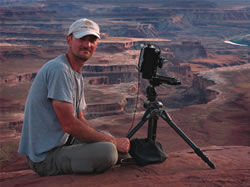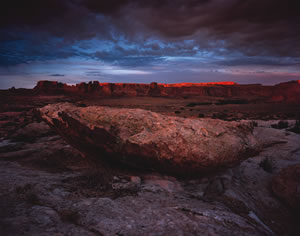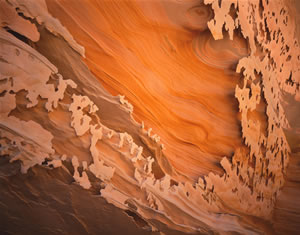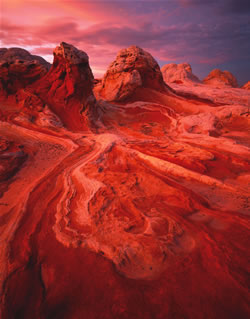
Patrick Paul René
Photo by Judy Martinez-Ross |
Like the world-renowned French singer
Edith Piaf, who sings of life seen through pink glasses
in her signature song, “La Vie en Rose,” Patrick
Paul René sees the world around him in varying hues
of rose, ochre and red.
René is a French photographer whose passion for
the mystical desert landscapes of the Southwest has inspired
him to make Moab his home. Although many people find this
area fascinating and mysterious, this photographer distinguishes
his work by portraying places off the beaten path in the
most glamorous light.
Bathed in reflected morning or evening sunlight, the images
René captures evoke an emotional response, including
timelessness, tranquility and solitude.
Each image in René’s portfolio
is arresting, and represents hours of patience and years
of planning. As he succinctly expresses in his artist statement, “I
will spend hours and sometimes days waiting for that magic
moment when I see with my eyes what my imagination has shown
me. It is the possibility of capturing perfection in a photograph
that keeps my passion high and my vision in tune with the
desert’s solitude and beauty.”
The process he uses to capture these photos can be broken
down into two main parts. The first consists of finding the
location. An avid outdoor enthusiast, René often hikes
and camps to remote areas of wilderness. His wife, Judy Martinez-Ross,
who works at Arches National Park, sometimes accompanies
him and often encourages him in his pursuit.
When he comes across scenery that speaks to him, he scouts
it out with a digital camera. This enables him to explore
different possibilities for composition, deciding what part
of the landscape to include and what part to focus on.
René claims that the composition is the easy part
of capturing the intended image. Once he sees a landscape
that he wants to photograph, he envisions the captured image
in his mind, and it can take years before he feels like he
achieves that photo.

Fallen Moon |
An entire year was spent on getting the
mood he wanted to evoke in the most recent addition to his
portfolio, “Fallen Moon.” The photo features
storm clouds and a crescent-shaped rock in the foreground
set against a butte in the distance whose rim is reflecting
fiery morning sunlight.
He discovered the area and composed the shot a year before
capturing this particular image on film because he waited
patiently for the right light. Rather than relying purely
on luck, René envisions an image and pursues it until
nature seems to collaborate with him and provides this dramatic
light. He claims with a sense of wryness that “it was
a huge relief” once he took this particular photo in
April of this year because it meant he didn’t have
to keep returning to the same place.
To capture the precision of detail he wants and to be able
to enlarge his photos, René uses a large-format camera.
The film measures 4 x 5 inches. Because of its expense, he
takes very few actual shots with it.
René is definitely friendly and easy to talk with,
but he is clearly an introspective person, comfortable spending
time on his own. This ability to enjoy solitude is reflected
in his images, where human tracks rarely appear.
Apart from two photos featuring Ancient Pueblo pictographs,
René’s images depict faraway horizons and endless
vistas. These vast landscapes represent an entry way into
a mystical new world that is as foreign as it is familiar,
making the viewer ask, “Where is this and can I go
there, too?”
René asserts that part of his purpose in taking these
photographs is to encourage people to visit the wilderness.
He says, “I want to entice people to get out and see
how beautiful it is.”
Because of this desire to represent the
landscapes in their true and pure forms, he avoids using
special effects to enhance his photos, other than to ensure
that the colors on paper are true to the ones he saw in real
life.
A unifying element in his photography is the warm, saturated
sunlight, where reds and golds linger in the viewer’s
mind as an afterimage. The predilection for these glowing
colors is not surprising when René reveals that he
was born in Rousillon, France, whose name reflects its red
coloring.
 Desert Lace
Desert Lace |
He admits that the large format he uses
is particularly adept at reproducing the magnificent colors
he finds in nature, and the warm hues of gold, pink, purple
and red that illuminate his images are true to reality. René uses
his lens and his mastery of photographic techniques to recreate
exactly what he perceives in real life.
Besides luminous color, the other feature that stands out
in his images is texture. Again, the large format he prefers
allows him to portray in detail the striations, roughness
and depth of the rocks he photographs.
In “Desert Lace,” the outer layer of thin rock
appears deceptively fragile. The shadows cast against the
golden wave-like pattern of the underlying sandstone creates
the appearance that the lace-like formations almost float
above. The depicted texture evokes a strong desire in the
viewer to reach out and touch this fantastic formation, whose
ephemeral appearance belies the hardness of the rock.
This focus on surface appears again in “Burning
Hills,” in which the sandstone striations take on the
illusion of flowing lava. The luminous reds and pinks of
this photo imbue the landscape with an otherworldliness.
Yet, René asserts that this is an earthly image that
he feels lucky to have caught on film so quickly.
 Burning
Hills |
Where many of his photos have taken months,
if not years, to capture under the right light, he discovered
this area while it was bathed in this ethereal golden sunset.
He went straight for his large format camera, running from
one vantage point to another, trying to capture this world
gradually morphing in front of his eyes. In the dwindling
sunlight, he paused and took a moment to compose this particular
image, which turned out the best of the series and resides
in his portfolio.
Likening René to his compatriot Edith Piaf in her
signature song of viewing life through rose-colored lenses
is slightly misleading because he strives to create accurate
accounts of wilderness landscapes in their most breath-taking
moments and colors. In fact, René eschews filtering
the world through a deceptive color, preferring to depict
it in its naturally magnificent hues and shapes.
Patrick Paul René can be reached at (435) 259-3199
or at patrickpaulrene@hotmail.com. His work can also be seen
in Petra Gallery and at Earth Studio, both in Moab, Utah. |



